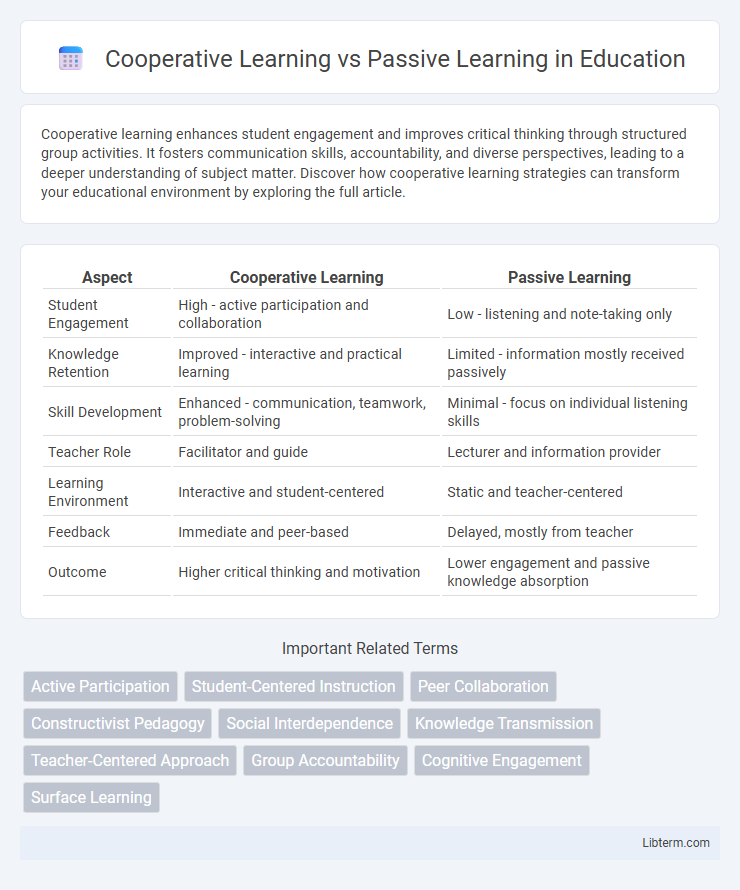Cooperative learning enhances student engagement and improves critical thinking through structured group activities. It fosters communication skills, accountability, and diverse perspectives, leading to a deeper understanding of subject matter. Discover how cooperative learning strategies can transform your educational environment by exploring the full article.
Table of Comparison
| Aspect | Cooperative Learning | Passive Learning |
|---|---|---|
| Student Engagement | High - active participation and collaboration | Low - listening and note-taking only |
| Knowledge Retention | Improved - interactive and practical learning | Limited - information mostly received passively |
| Skill Development | Enhanced - communication, teamwork, problem-solving | Minimal - focus on individual listening skills |
| Teacher Role | Facilitator and guide | Lecturer and information provider |
| Learning Environment | Interactive and student-centered | Static and teacher-centered |
| Feedback | Immediate and peer-based | Delayed, mostly from teacher |
| Outcome | Higher critical thinking and motivation | Lower engagement and passive knowledge absorption |
Introduction to Cooperative and Passive Learning
Cooperative learning fosters active student engagement through group collaboration, promoting critical thinking, communication, and problem-solving skills. In contrast, passive learning involves students receiving information without interaction, often through lectures or readings, which may limit retention and understanding. Research consistently shows cooperative learning enhances academic achievement and social skills compared to passive instructional methods.
Defining Cooperative Learning
Cooperative learning is an educational approach where students work together in small groups to achieve shared learning goals, actively engaging in discussion, problem-solving, and peer teaching. This method contrasts with passive learning, where students primarily receive information through lectures without interactive participation. Research shows cooperative learning enhances critical thinking, retention, and social skills by fostering collaboration and active involvement in the learning process.
Understanding Passive Learning
Passive learning involves students receiving information without active engagement, typically through lectures or reading without interaction. This method often leads to lower retention and limited critical thinking skills compared to cooperative learning. Research shows that passive learning can hinder deep understanding as students are less likely to process and apply knowledge actively.
Key Differences Between Cooperative and Passive Learning
Cooperative learning involves active student engagement through group collaboration, enhancing critical thinking, communication, and problem-solving skills, whereas passive learning relies on individual absorption of information, typically via lectures or note-taking. Key differences include the interactive nature of cooperative learning fostering peer-to-peer interaction and immediate feedback, while passive learning emphasizes one-way knowledge transfer from instructor to student. Studies show cooperative learning leads to higher retention rates and deeper understanding compared to passive learning's limited student participation and engagement.
Benefits of Cooperative Learning
Cooperative learning enhances student engagement and retention by promoting active participation and peer interaction, which improves critical thinking and communication skills. Research shows cooperative learning increases academic achievement and motivation compared to passive learning methods that rely on memorization and minimal student interaction. The collaborative environment fosters social skills and accountability, leading to deeper understanding and long-term knowledge retention.
Drawbacks of Passive Learning
Passive learning often results in limited student engagement and poor knowledge retention, as learners primarily absorb information without active participation. This approach can hinder critical thinking and problem-solving skills development because it does not encourage interaction or practical application. Studies show that students in passive learning environments frequently struggle with motivation and long-term comprehension compared to those in cooperative learning settings.
Classroom Strategies for Cooperative Learning
Classroom strategies for cooperative learning include structured group activities, peer teaching, and collaborative problem-solving tasks that encourage active student participation and shared responsibility. Techniques such as jigsaw, think-pair-share, and group investigations promote critical thinking, communication skills, and deeper understanding compared to passive learning methods like lectures or individual reading. Implementing cooperative learning effectively increases student engagement, improves retention, and fosters positive social interactions in diverse classroom settings.
Impact on Student Engagement and Motivation
Cooperative learning significantly enhances student engagement by fostering active participation and collaborative problem-solving, which increases intrinsic motivation and accountability within the group. In contrast, passive learning often leads to decreased attention and motivation due to its reliance on one-way information delivery and minimal student interaction. Research indicates that cooperative learning strategies improve academic achievement and promote positive social skills, making them more effective for sustaining long-term student motivation.
Research Findings on Learning Outcomes
Research findings consistently show that cooperative learning significantly enhances student engagement and academic achievement compared to passive learning methods. Studies reveal that cooperative learning fosters critical thinking, higher retention rates, and improved problem-solving skills by promoting active participation and peer interaction. In contrast, passive learning often leads to lower comprehension and limited knowledge application due to minimal student involvement.
Choosing the Right Approach for Your Classroom
Cooperative learning fosters active engagement by encouraging students to collaborate, share ideas, and develop critical thinking skills, making it effective for diverse and interactive classrooms. Passive learning, characterized by lecture-style teaching and limited student interaction, may benefit larger classes where information delivery efficiency is prioritized over participation. Selecting the right approach depends on class size, learning objectives, and student needs to maximize understanding and retention.
Cooperative Learning Infographic

 libterm.com
libterm.com